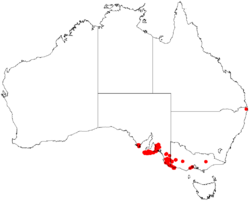Biology:Lepidosperma canescens
| Lepidosperma canescens | |
|---|---|
| Scientific classification | |
| Kingdom: | Plantae |
| Clade: | Tracheophytes |
| Clade: | Angiosperms |
| Clade: | Monocots |
| Clade: | Commelinids |
| Order: | Poales |
| Family: | Cyperaceae |
| Genus: | Lepidosperma |
| Species: | L. canescens
|
| Binomial name | |
| Lepidosperma canescens | |

| |
| Occurrence data from AVH | |
Lepidosperma canescens (common name hoary rapier-sedge)[3] is a sedge of the family Cyperaceae that is native to south-east South Australia and Victoria.[4] There are no synonyms.[1][4]
Description
Lepidosperma canescens is a clump-forming perennial with short rhizomes. It has terete, rigid, erect, and smooth culms which are 25–100 cm by 0.8–2.0 mm. The leaf-blades are similar to the culms but usually shorter and from 0.7–2 mm in diameter. The sheaths are yellow-brown to dark grey-brown, and are sometimes a dark reddish near the apex. They are not sticky. The inflorescences are fan-shaped to oblong. They are loose, erect, and 3–8 cm by about 2 cm. The involucral bract is shorter than the inflorescence. The spikelets are 5–7 mm long. The nut is obovoid (2–3 mm by 1.0–1.3 mm), and brown, smooth, and shining.[5]
Uses
This sedge was used by Aborigines for weaving artefacts, and is used by the aboriginal artist, Yvonne Koolmatrie, for her weaving.[6][7][8]
References
- ↑ 1.0 1.1 "Lepidosperma canescens". Australian Plant Name Index (APNI), IBIS database. Centre for Plant Biodiversity Research, Australian Government. https://biodiversity.org.au/nsl/services/rest/name/apni/85499.
- ↑ Boeckeler, J.O. (1874). "Die Cyperaceen den Königlichen Herbariums zu Berlin". Linnaea: Ein Journal für die Botanik in ihrem ganzen Umfange, oder Beiträge zur Pflanzenkunde 38 (3): 330. https://www.biodiversitylibrary.org/page/122201.
- ↑ "Fact sheet for Lepidosperma canescens". http://www.flora.sa.gov.au/cgi-bin/speciesfacts_display.cgi?form=speciesfacts&name=Lepidosperma_canescens.
- ↑ 4.0 4.1 "Lepidosperma canescens Boeckeler | Plants of the World Online | Kew Science". http://powo.science.kew.org/taxon/urn:lsid:ipni.org:names:310103-1.
- ↑ "Flora of Victoria: Lepidosperma canescens". https://vicflora.rbg.vic.gov.au/flora/taxon/a29a5b0d-dbf7-49df-a0b9-74abf96f061b.
- ↑ Selling Yarns (2007-08-12), River Bunyip: Yvonne Koolmatrie, 2003, https://www.flickr.com/photos/sellingyarns/3229108443/, retrieved 2020-03-13
- ↑ Barritt, Michael J. (2018-04-14), Yvonne Koolmatrie, River Dreaming, 2012, sedge rushes (Lepidosperma canescens)., https://www.flickr.com/photos/centralaustralia/40551106755/, retrieved 2020-03-13
- ↑ Hall (Teniche), Theresa (2017-07-06), Sister baskets. Artist: Yvonne Koolmatrie, https://www.flickr.com/photos/theresahall/34932213474/, retrieved 2020-03-13
Wikidata ☰ Q15549092 entry
External links
- Lepidosperma canescens occurrence data from Australasian Virtual Herbarium
- Lepidosperma canescens Seeds of South Australia (for images)
- Lepidosperma canescens (Google image search)
 |

